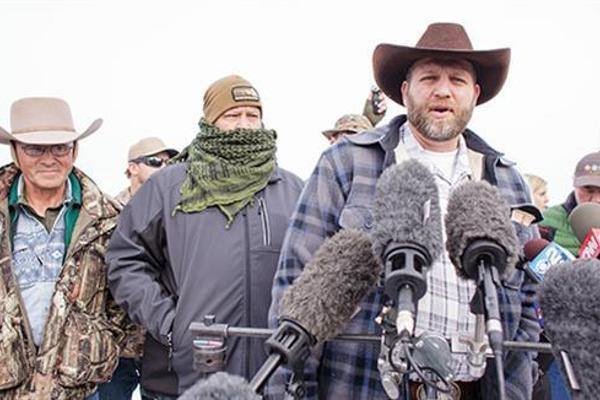Oregon sheriff demands anti-government miltiamen leave community
BURNS, Oregon - Reuters


Ammon Bundy(R), leader of a group of armed anti-government protesters speaks to the media as other members look on at the Malheur National Wildlife Refuge near Burns, Oregon January 4, 2016. AFP Photo
A county sheriff and judge on Jan. 4 demanded that self-styled militiamen occupying a remote U.S. wildlife center in Oregon peacefully end their 3-day-old anti-government siege, telling the protesters: "It's time for you to leave our community."The flashpoint for the Jan. 2 takeover of the headquarters of the Malheur National Wildlife Refuge outside the town of Burns, Oregon, was the imminent incarceration of two ranchers convicted of arson and re-sentenced to longer prison terms.
But the occupation marked the latest flare-up of anger against the U.S. government over federal management of public land in the West, long seen by political conservatives in the region as an intrusion on individual freedom and property rights.
Federal authorities have so far kept their distance from the wildlife refuge, which remained closed to visitors.
The FBI said in a statement it was seeking a "peaceful resolution to the situation," while Obama administration officials said U.S. law enforcement officers had been told to avoid a violent confrontation with the occupiers.
Protest leader Ammon Bundy, whose father's ranch in Nevada was the scene of an armed standoff against federal land managers in 2014, told reporters on Jan. 4 his group had named itself Citizens for Constitutional Freedom and was making a stand for personal liberty.
"They (the federal government) are coming down into the states and taking over the land and the resources, putting the people into duress, putting the people into poverty," he said.
Flanked by supporters, Bundy declined to say how many were participating in the takeover. But about a half-dozen occupiers were visible to reporters, some in a watchtower on the property and others standing around a vehicle used to block an access road.
The two ranchers whose cause Bundy's group has embraced - Dwight Hammond Jr., and his son, Steven - turned themselves over to federal authorities in California earlier on Jan. 4.
Some residents in Burns, a town of some 3,000 people about 280 miles (451 km) southeast of Portland, voiced sympathy with the militia group's cause, if not its methods.
But many said they viewed the occupation as mostly, if not entirely, the work of outside agitators - a sentiment echoed by Harney County Sheriff David Ward.
"You said you were here to help the citizens of Harney County," Ward said at a news conference in Burns, addressing Bundy's group in a statement he read on behalf of himself and county Judge Steven Grasty. "It is time for you to leave our community, go home to your families, and end this peacefully."
The sheriff said the takeover had "significantly impacted" the local community, where authorities have closed public schools and some government offices as a precaution.
Three administration officials told Reuters that federal authorities were following U.S. policy guidelines instituted to prevent such standoffs from turning violent in the wake of deadly clashes at Ruby Ridge, Idaho, and Waco, Texas in the early 1990s.
Sagebrush rebellion
The Oregon occupation marked the latest skirmish in the so-called sagebrush rebellion, a decades-old conflict over federal control of millions of acres (hectares) of land and natural resources in the West, much of it administered by the Interior Department, parent agency of the U.S. Fish and Wildlife Service.
It followed a demonstration in Burns over the case of the Hammonds, who were found guilty in 2012 of setting a series of fires, including a 139-acre (56-hectare) blaze in 2001 intended to cover up evidence of wildlife poaching, according to federal prosecutors.
The younger Hammond was initially sentenced to 12 months in prison and the father three months, below the federal minimum for arson. In October, a U.S. district judge increased the sentences to five years.
Through an attorney, they have dissociated themselves from Bundy's group.
Residents interviewed by Reuters said that while the U.S. government could sometimes seem overzealous in enforcing rules on ranchers, it was also a major local employer.
Wendy Bull, a teacher, came to listen to the sheriff's remarks in part so she could ask when her husband, a social worker, could reopen a local clinic run by the U.S. Veteran Affairs Department.
"I believe that they are domestic terrorists," she said of the occupiers.
Patrick Wright, 33, a taxi driver who said he knew the Hammonds, agreed with the protesters that sending the two men back to prison was unfair.
"I get why they're here," Wright said of the occupiers. "Taking over the refuge and threatening gun violence is a little extreme, but it's getting them heard, that's for sure."
Bundy is the son of Nevada rancher Cliven Bundy, whose ranch was the scene of an armed demonstration against federal Bureau of Land Management officials in 2014 that ended with the authorities backing down, citing safety concerns.
That standoff drew hundreds of armed protesters after federal agents sought to seize Bundy's cattle because he refused to pay grazing fees.
The takeover in Oregon drew criticism on social media, with some users asking if the occupiers would have been treated differently if they had been black or Muslim.
The Hammond ranch borders the southern edge of the Malheur refuge, a bird sanctuary in eastern Oregon's arid high desert, about 305 miles (490 km) southeast of Portland.
